Adult Scoliosis Treatment Overview
Adult scoliosis refers to any case of scoliosis occurring in an individual over the age of eighteen. Individuals with adult scoliosis are skeletally mature and have distinct differences in terms of their presentation for treatment as well as for treatment options in comparison to their pediatric counterparts. Adult scoliosis encompasses a broad group of individuals who have varying causes of their spinal deformity. These include idiopathic scoliosis, with its onset in childhood but presenting with pain and worsening deformity in the adult. Other causes include congenital anomalies that arise in-utero, degenerative scoliosis caused by disc degeneration, post traumatic scoliosis (occurring as a result of fractures of the spine), and neuro- muscular scoliosis often seen in patients with polio, muscular dystrophies, or other neuromuscular disorders.
The adult differs from the pediatric patient in that spinal curvature tends to be associated with back pain which is often the main presenting complaint. Curvature in the adult also tends to be severe and is often progressive. Furthermore, curvature in the adult tends to be very rigid or stiff, presenting treatment challenges to the surgeon. Often, advanced stages of disc degeneration are associated with adult scoliosis. This may be the primary reason for back pain in many patients. Neurological deficits as a result of pinched nerves from herniated discs and arthritic changes may occur. It is common for patients in late middle age and beyond to have problems of osteopenia (low bone density) or osteoporosis. These issues are all important in the treatment of the patient with adult scoliosis.
Non-Operative Treatment
Treatment for the majority of individuals with adult scoliosis is non operative. After thorough evaluation of the patient, the surgeon is able to determine the source of the patient’s pain and address the non operative treatment regimen to the specific offending problems. Exercise and conditioning is often the mainstay of non operative treatment and helps the patient maintain function and energy level and control back pain. This is combined with physical therapy and the judicious use of non-steroidal anti-inflammatory medications such as Ibuprofen (Motrin) in many patients. Nerve root blocks or epidural steroid injections may help to alleviate leg pain occurring as a result of pinched nerves in the lumbar spine (lower back). Bracing is rarely used in the adult patient but may be indicated in an elderly patient who is not a surgical candidate in an attempt to provide some comfort. Unfortunately, bracing is not always well tolerated in the elderly patient. We avoid bracing in the middle age patient so as to minimize the problem of muscle deconditioning associated with bracing. Osteoporosis and osteopenia are treated with appropriate dietary modifications including calcium and vitamin D supplementation as well as exercise (see section in patient resources on osteoporosis).
Operative Treatment
Surgery is indicated for patients in whom curvatures have worsened over time, that are associated with pain that is unresponsive to non operative treatment, or that are associated with neurological deficits. Another indication for surgery is unacceptable severe spinal deformity with varying degrees of symptoms. Contraindications to surgery apply to elderly patients who are not healthy enough to undergo such surgery or with severe osteoporosis that makes them poor candidates for surgical intervention. Surgery in the adult patient may be performed from the posterior (back) approach, a combined anterior (front) and posterior approach, or from an anterior approach alone for lumbar or thoracolumbar scoliosis. Often, extensive osteotomies (cutting through bone) in rigid deformities, or vertebral column resection in which entire vertebra are removed in the most severe deformities are performed in order to re-align the spine as safely as possible. Often, discs in the lower lumbar region are severely degenerated, requiring the fusion to be extended down to the sacrum. Obtaining a fusion down to the sacrum can be challenging and often makes anterior - posterior surgery necessary. Pelvic fixation may be required to provide optimal holding power.
The length of recovery following surgery for adult scoliosis is variable depending on the nature of the deformity preoperatively, the extent of surgery required and the age of the patient. Patients may get back to full activities as soon as three months after surgery, or as late as six to nine months following the procedure. Often, patients benefit from a brief period of time in an inpatient rehabilitation facility following the initial hospital stay.
We have found that the adult patient undergoing scoliosis surgery is amongst the happiest of our patients in that their pain is markedly improved or eradicated, their deformity is corrected and they are able to return to an active lifestyle.
We look forward to speaking to you about your individual problem in our office.
Adult Scoliosis Case Example #1
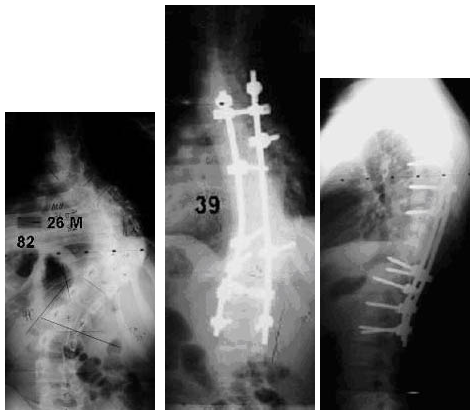
This 26 year old gentleman had an 82 degree painful thoracic curvature. This was treated by thoracoscopic release (disc removal) and posterior fusion with instrumentation resulting in excellent balanced correction and relief of his pain.
Adult Scoliosis Case Example #2
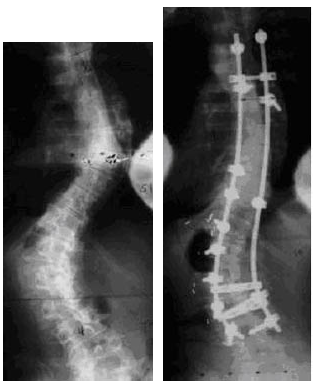
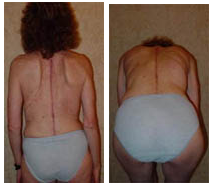
This 51 year old female triathlete and dental hygienist professional teacher had a progressive lumbar curvature that became increasingly disabling. She was treated with combined anterior and posterior surgery including osteotomies to reestablish spinal balance and improve her pain and function. The patient returned to her work and recreational activities within several months after her surgery. She has been able to ride up to 100 miles on her bicycle and has returned to skiing as well. Dr. Lonner has counseled her not to continue running.
Adult Scoliosis Case Example #3
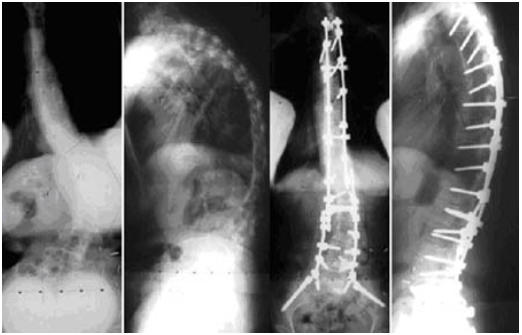
This 77 year old woman had severe scoliosis and kyphosis associated with severe back pain. She was treated with combined anterior and posterior surgery including fixation to the pelvis. She did very well and is highly satisfied. Of note, some patients in this age category may not be healthy enough to undergo such extensive surgery.
Adult Scoliosis Case Example #4
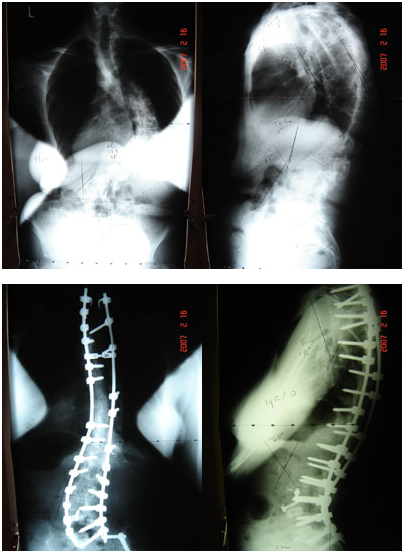
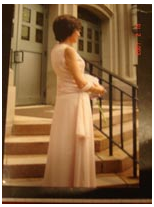
This 54 year old female had severe scoliosis of 87 degrees with associated back pain and significant deformity. She finally decided to undergo surgery when her students began questioning her obvious deformity. She underwent anterior/posterior spinal fusion surgery and returned to her position as a teacher within 3 months after her surgery. She was very pleased with her outcome, so much so she sent us a picture of herself at her daughter’s wedding.
Adult Scoliosis Case Example #5
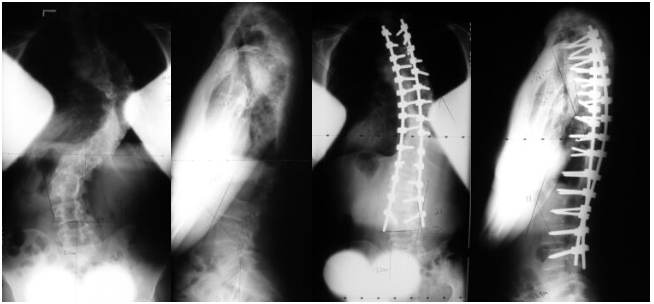
This is a 48 year old female with progressive scoliosis reaching 86 degrees. The patient underwent a combined anterior/posterior spinal fusion surgery and is quite pleased with her results.
